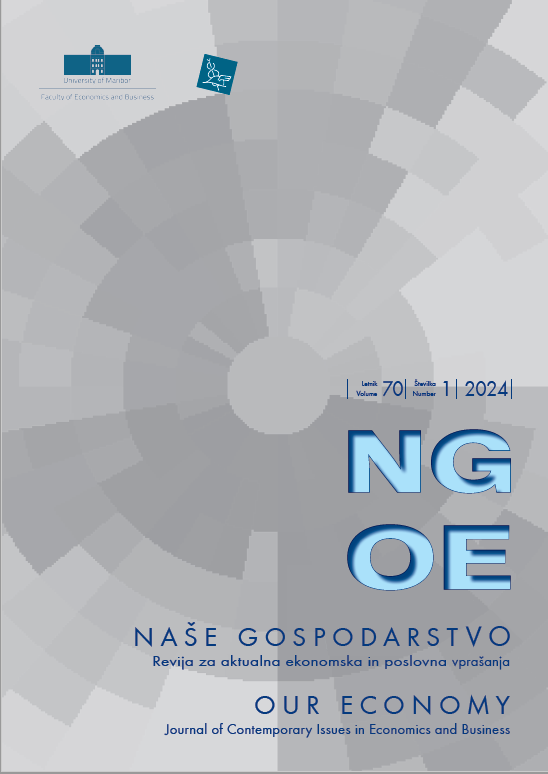Wage Function Estimation of Estonia and Latvia
Keywords:
Wage function, OLS, Estonia, LatviaAbstract
The study of wage determinants goes back to the beginning of economic science, with theoretical and empirical foundations providing the basis for the specification of a model of the wage function. Using the OLS method, we study the determinants of real wages for Estonia between 2006Q3 and 2022Q3 and Latvia between 2004Q1 and 2022Q3. The lagged dependent variable exerts the most considerable impact on real wages, i.e., real wages in the preceding quarter. We find that unemployment has a relatively larger impact on real wage dynamics than real productivity in the Latvian than in Estonian model. In the Estonian model, real productivity has a relatively stronger impact than unemployment in explaining real wages. In both countries, changes in real productivity impact real wages with a one-quarter lag. The findings on the relative influence of real wage determinants guide economic policymakers in targeting measures that could increase real wages in both countries.
Downloads
References
Apergis, N., & Theodosiou, I. (2008). The Employment–Wage Relationship: Was Keynes right after all? American Review of Political Economy, 6(1), 40-50. DOI: http://dx.doi.org/10.38024/arpe.100.
Bae, S.-O., & Patterson, L. (2014). Comparison and Implications of Human Capital Theory at the Individual, Organization, and Country Levels. Journal of Organizational Culture, Communications and Conflict, 18(1), 11-28. Retrieved from https://www.proquest.com/openview/37f9ad5541bf53a9520482b8a005e7a3/1?pq-origsite=gscholar%26cbl=38870.
Blanchflower, D. G., & Osvald, A. J. (1994). Estimating a Wage Curve for Britain 1973-90. The Economic Journal, 104, 1025-1043.
Cruz, M. D. (2023). Labor Productivity, Real Wages, and Employment in OECD Economies. Structural Change and Economic Dynamics, 66, 367-382. DOI: http://dx.doi.org/10.1016/j.strueco.2023.05.007.
Das, P., Basu, R., & Halder, A. (2017). Employment, Wage and Productivity: Analysis of Trend and Causality. The Journal of Industrial Statistics, 6(1), 41-56. https://www.mospi.gov.in/sites/default/files/reports_and_publication NSS_Journals/jr3_6_1March2017.pdf.
Dritsaki, C. (2016). Real wages, inflation, and labor productivity: Evidences from Bulgaria and Romania. Journal of Economic and Financial Studies, 4(5), 24-36. DOI: http://dx.doi.org/10.18533/jefs.v4i05.253.
Elgin, C., & Kuzubas, T. U. (2013). Wage-Productivity Gap in OECD Economies. Economics: The Open-Access, 7, 2013-2021. DOI: http://dx.doi.org/10.5018/economics-ejournal.ja.2013-21.
Eryilmaz, F., & Bakir, H. (2018). Real Wages, Inflation and Labor Productivity: An Evaluation within Turkish Contex. Hitit University Journal of Social Sciences Institute, 11(3), 1946-1959. DOI: http://dx.doi.org/10.17218/hititsosbil436936.
European Bank for Reconstruction and Development. (2022). Diagnostic of Estonia, Latvia and Lithuania. London: European Bank for Reconstruction and Development. Retrieved from https://www.ebrd.com/publications/country-diagnosticsestonia-latvia-lithuania.
Eurostat. (2020). Income Inequality and Poverty Indicators. Retrieved from https://ec.europa.eu/eurostat/webexperimental-statistics/income-inequality-and-poverty-indicators.
Eurostat. (2023a). Main GDP Aggregates per Capita. Retrieved from https://ec.europa.eu/eurostat/databrowser/view/NAMA_10_PC__custom_6840860/default/table?lang=en.
Eurostat. (2023b). GDP and Main Components (Output, Expenditure and Income). Retrieved from https://ec.europa.eu/eurostat/databrowser/view/namq_10_gdp/default/table?lang=en.
Eurostat. (2023c). HICP - Monthly Data (annual rate of change). Retrieved from https://ec.europa.eu/eurostat/databrowser/view/prc_hicp_manr/default/table?lang=en.
Eurostat. (2023d). Unemployment by Sex and Age – Quarterly Data. Retrieved from https://ec.europa.eu/eurostat/databrowser/product/view/une_rt_q.
Eurostat. (2023e). Labour Productivity and Unit Labour Costs. Retrieved from https://ec.europa.eu/eurostat/databrowser/view/nama_10_lp_ulc/default/table?lang=en.
Gajewski, P., & Kutan, A. M. (2021). The Productivity–Real Wage Nexus in Emerging European Economies: Evidence from Poland. Eastern European Economics, 59(3), 250-270. DOI: http://dx.doi.org/10.1080/00128775.2021.1880271.
Gallegati, M., Gallegati, M., Ramsey, J. B., & Semmler, W. (2011). The US Wage Phillips Curve across Frequencies and over Time. Oxford Bulletin of Economics and Statistics, 73(4), 489-508. DOI: http://dx.doi.org/10.1111/j.1468-0084.2010.00624.x.
Galstyan, A., Grabowska, M., & Bačiulienė, V. (2021). Economic Development and Migration after EU Accesion: The case of Baltic states. Pressburg Economic Review, 1(1), 47-55. DOI: https://review.pressburgcentre.org/per/article/view/6.
Kahn, R. F. (2022). Unemployment as seen by the Keynesians. In: Marcuzzo, M.C., & Paesani, P. (eds), Palgrave Studies in the History of Economic Thought. Palgrave Macmillan, Cham. DOI: https://doi.org/10.1007/978-3-030-98588-2_11.
Klein, N. (2012). Real Wage, Labor Productivity, and Employment Trends in South Africa: A Closer Look. IMF Working Paper WP/12/92. Washington D. C.: IMF. DOI: http://dx.doi.org/10.5089/9781475502824.001
Kumar, S., Webber, D. J., & Perry, G. (2012). Real wages, inflation and labour productivity in Australia. Applied Economics, 44(23), 2945-2954. DOI: http://dx.doi.org/10.1080/00036846.2011.568405.
López-Villavicencio, A., & Silva, J. I. (2011). Employment Protection and the Non-Linear Relationship between the Wage-Productivity Gap and Unemployment. Scottish Journal of Political Economy, 58(2), 200-220. DOI: http://dx.doi.org/10.1111/j.1467-9485.2011.00543.x.
Masso, J., & Krillo, K. (2011). Labour Markets in the Baltic States During the Crisis 2008-2009: The Effect on Different Labour Market Groups. The University of Tartu Faculty of Economics and Business Administration Working Paper, 79. Tartu: The University of Tartu Faculty of Economics and Business Administration. DOI: https://dx.doi.org/10.2139/ssrn.1734378.
Meager, N., & Speckesser, S. (2011). Wages, Productivity and Employment: A Review of Theory and International Data. Brighton: Institute for Employment Studies.
Narayan, P., & Smyth, R. (2011). The Effect of Inflation and Real Wages on Productivity: New Evidence From a Panel of G7 Countries. Applied Economics, 41(10), 1285-1291. DOI: http://dx.doi.org/10.1080/00036840701537810.
Paulus, A., & Staehr, K. (2022). The Energy Crisis in the Baltic States: Causes, Challenges, and Policies. EconPol Forum, 23(6), 28-32. DOI: https://www.econstor.eu/bitstream/10419/272143/1/1822853818.pdf.
Pfajfar, L. (2018). Osnovna ekonometrija (2. iss.). Ljubljana: School of Economics and Business Ljubljana.
Seputiene, J. (2011). The Estimation of the Relationship between Wages and Unemployment in the European Union. International Journal of Social and Humanity Studies, 11(2), 1309-1318. Retrieved from https://dergipark.org.tr/en/download/article-file/257374.
Sharpe, A., & Peter Harrison, J.-F. A. (2008). The Relationship between Labour Productivity and Real Wage Growth in Canada and OECD Countries. Ottawa, Canada: Centre for the study of living standards.
Staehr, K. (2013). Austerity in the Baltic States During the Global Financial Crisis. Intereconomics, 48(5), 293-302. DOI: https://doi.org/10.1007/s10272-013-0472-9.
Sušjan, A. (2006). Uvod v zgodovino ekonomske misli (1. iss.). Ljubljana: School of Economics and Business Ljubljana.
Tang, C. F. (2014). The Effect of Real Wages and Inflation on Labour Productivity in Malaysia. International Review of Applied Economics, 28(3), 311-322. DOI: http://dx.doi.org/10.1080/02692171.2013.872084.
von Fintel, D. (2017). Institutional Wage-Setting, Labour Demand and Labour Supply: Causal Estimates from a South African Pseudo-Panel. Development Southern Africa, 34(1), 1-16. DOI: https://doi.org/10.1080/0376835X.2016.1269637.
Downloads
Published
Issue
Section
License
Copyright (c) 2024 Gašper Kolar, Nejc Fir

This work is licensed under a Creative Commons Attribution-NonCommercial-NoDerivatives 4.0 International License.
